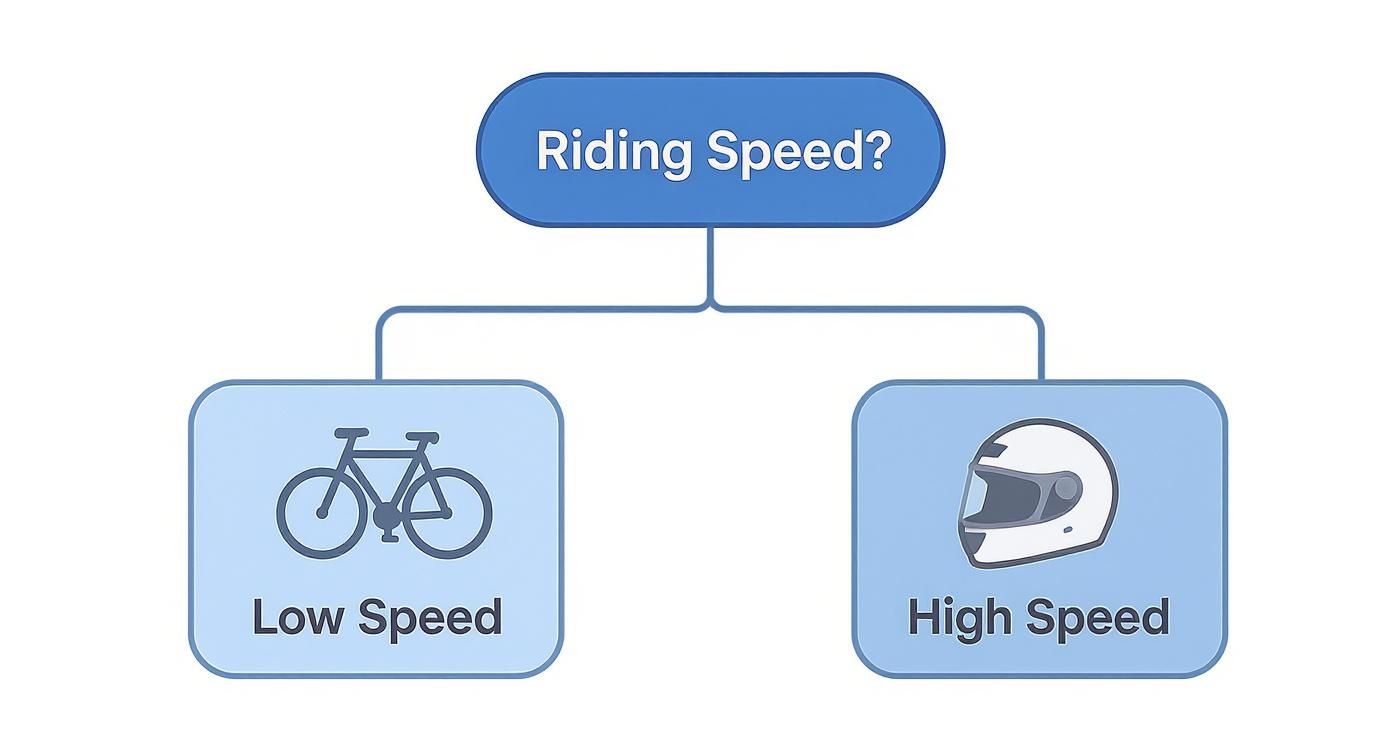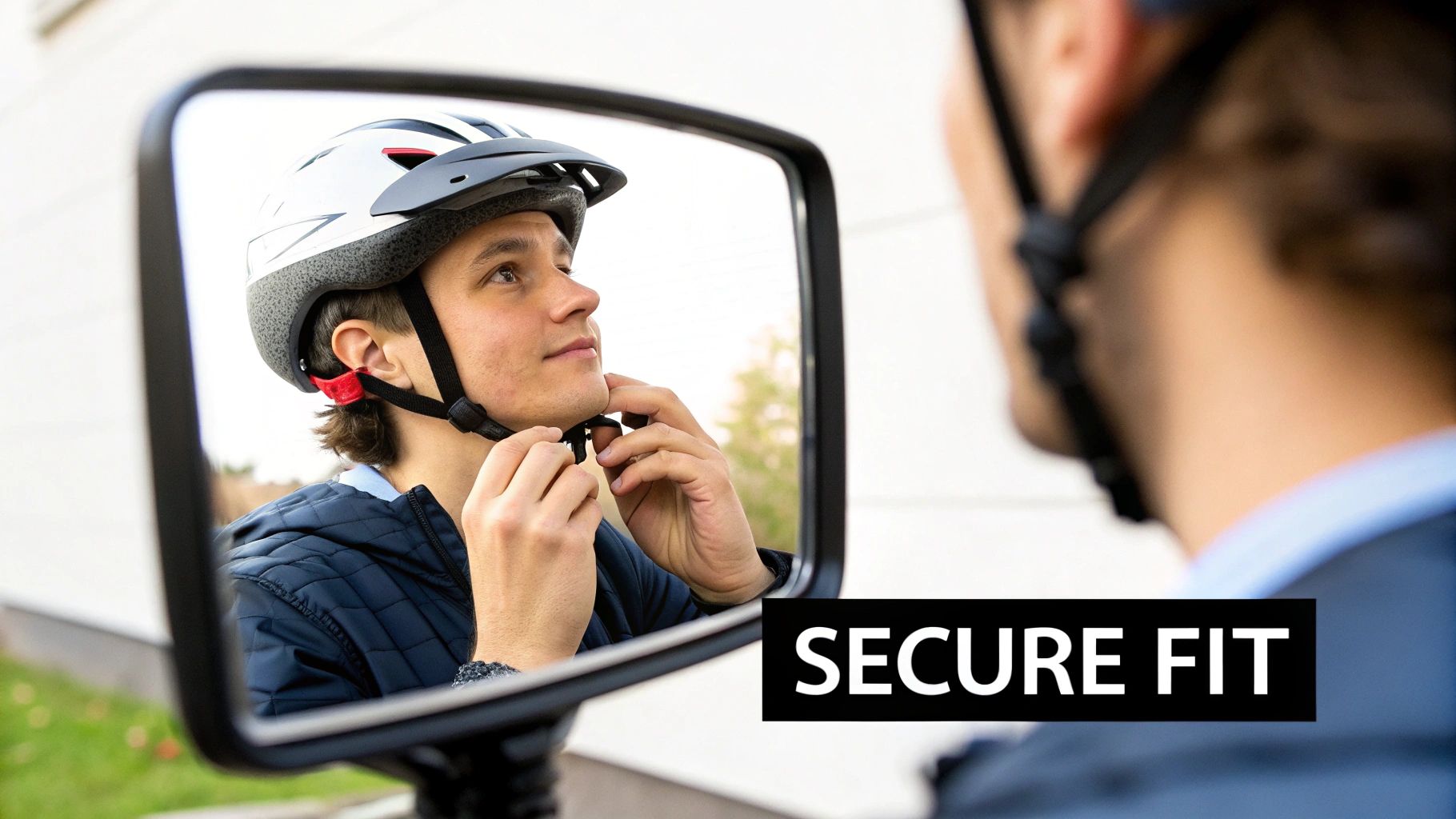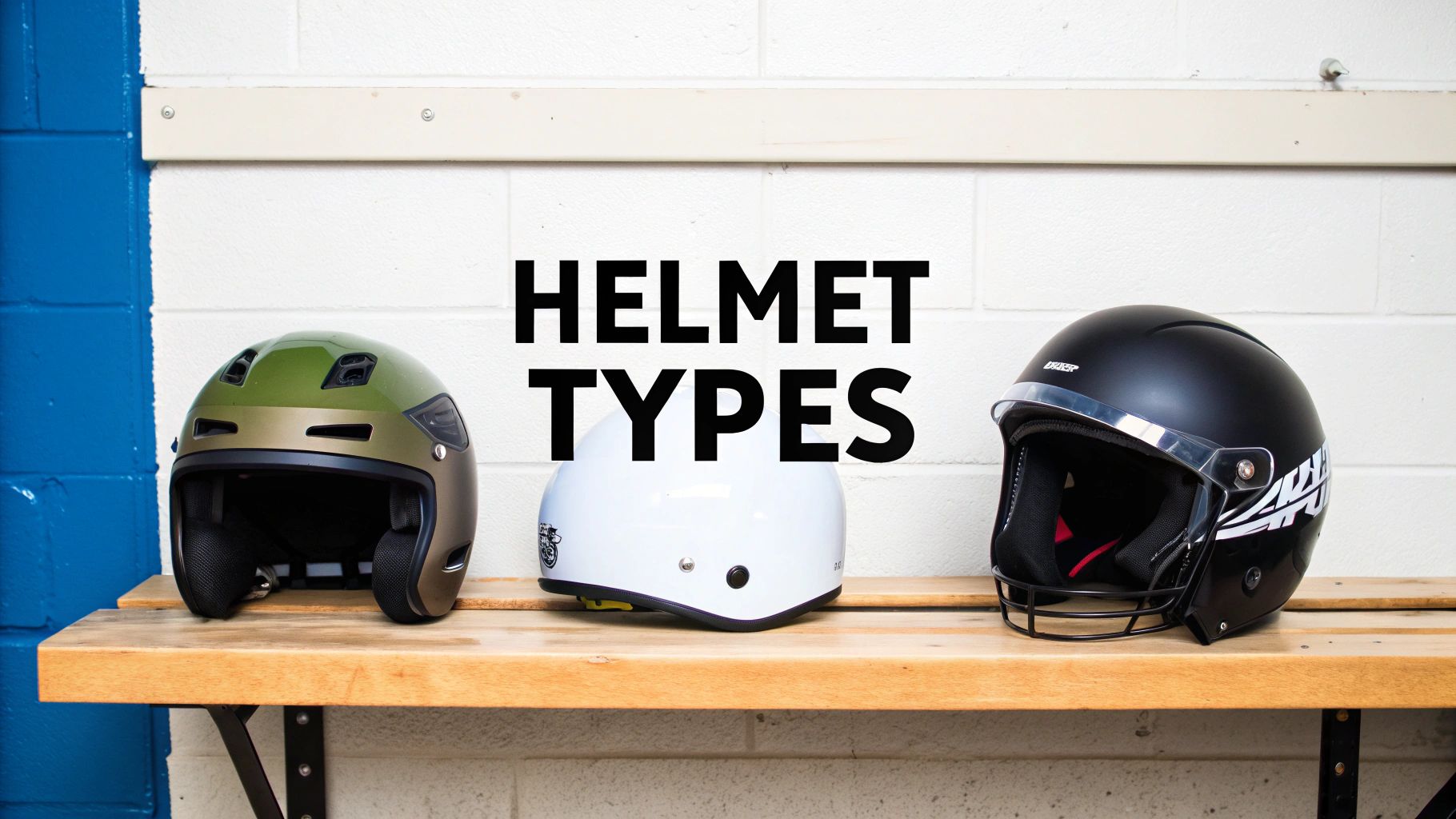Let's be real: figuring out the best helmet for your electric scooter comes down to one thing—matching your riding style to the right safety gear.
For most people zipping around town in the US and Australia, a helmet with CPSC or AS/NZS 2063 certification and maybe some MIPS tech is the sweet spot. It gives you a great mix of protection and comfort for daily commutes. But if you're riding a faster scooter, a full-face helmet is non-negotiable.
Why Your Helmet Choice Matters More Than Ever
Riding an e-scooter without a helmet is a massive gamble. It’s the single most important piece of gear you'll ever buy, standing between your head and the hard reality of pavement.
As scooters get faster and city streets get more crowded, having a helmet you can trust isn't just a good idea—it's essential.
The stats don't lie. Electric scooter injuries in the U.S. shot up from 64,312 in 2023 to 115,713 in 2024. That's a staggering 80% jump in just one year, and it screams one thing: we all need to take head protection seriously.
Matching Your Helmet To Your Ride
Picking the right helmet goes beyond just looking for a safety sticker. It’s about being honest about how you ride. Are you cruising in the bike lane, or are you weaving through traffic on a scooter that can really move? That answer changes the whole game.
This decision tree breaks it down perfectly, showing how your speed should be the first thing you think about.

As you can see, if you're keeping things casual at lower speeds, a good bicycle helmet will do the trick. But once you start pushing the throttle, you need the serious protection that only a motorcycle-style helmet can offer.
Summary Of Top Helmet Features
To help you get a quick handle on the options, here’s a table breaking down the key differences between helmet types, their certifications, and the tech inside them.
| Helmet Type | Safety Certification | Protective Technology | Ideal Use |
|---|---|---|---|
| Full-Face | DOT / ECE | MIPS, EPS liners | High-speed riding, daily commuting in traffic |
| Modular | DOT / ECE | MIPS, EPS liners | Versatile commuting, long-distance rides |
| Open-Face | DOT / ECE / CPSC | MIPS, EPS liners | Casual city riding, warm weather |
| Bicycle | CPSC / EN 1078 / AS/NZS 2063 | MIPS, WaveCel | Low-speed commutes, recreational rides |
This table gives you a bird's-eye view, making it easier to see which features line up with your specific needs on the road.
Your helmet is an investment in your own well-being. A great helmet doesn't just protect you; it gives you the confidence to ride smart and safe, whether you're heading to work or just exploring.
At the end of the day, the best helmet is the one that's certified safe, fits you perfectly, and is comfortable enough that you'll actually wear it every single time. Honestly, choosing the right helmet is just as important as choosing the right scooter.
To get the full picture, check out our comprehensive electric scooter buying guide to make sure your entire setup is on point.
Understanding Helmet Safety Certifications
When you're shopping for a helmet, you’ll find a bunch of acronyms on stickers inside: DOT, CPSC, EN 1078. These aren't just alphabet soup; they're proof that the helmet has been through a gauntlet of rigorous scientific tests designed to mimic real-world crashes.
Think of these certifications as a helmet’s diploma from safety school. It’s your only guarantee that it’s built to do its job.
An uncertified helmet is a complete wild card. It might look tough, but when you actually need it, the shell could crack or the liner could fail completely. A certified helmet, on the other hand, is proven to absorb impact, resist getting pierced, and—most importantly—stay on your head during a crash.
This isn’t just theoretical. A German study found that over 50% of patients hitting the ER after an e-scooter accident had head injuries. The scary part? Not a single one of them was wearing a helmet. This is exactly the kind of dangerous gap that certified helmets are designed to prevent. You can dig into the e-scooter injury findings and what they mean for public health yourself.
Key Certifications in Major Regions
Helmet safety standards aren't a one-size-fits-all deal. They change depending on where you live to reflect local laws and typical riding conditions. Knowing which sticker to look for is your first step toward getting the right protection.
Here’s a quick rundown of the main certifications you’ll run into:
- CPSC (USA): The U.S. Consumer Product Safety Commission sets this standard, and it's mandatory for any bicycle helmet sold in the States. The testing is a bit tougher than EN 1078, with drops from a greater height. This is your go-to standard for casual urban scooter riding in the US.
- DOT (USA): This one stands for the Department of Transportation (specifically, the FMVSS 218 standard). It’s actually for motorcycle helmets and involves much more intense testing for impact absorption and penetration. If you're riding a high-speed electric scooter in the US, this is a great certification to look for.
- AS/NZS 2063 (Australia/New Zealand): The joint standard for bicycle helmets down under. It’s pretty similar in rigor to the CPSC standard, ensuring riders in Australia and New Zealand are well-protected on their scooters.
- EN 1078 (UK and EU): This is the European standard for bicycle and skateboard helmets. The tests involve dropping the helmet onto both flat and curb-shaped anvils to see how well it absorbs a hit.
A safety certification isn't just a sticker; it’s a promise. It tells you that independent experts have slammed, dropped, and stressed that helmet to make sure it holds up when things go wrong.
What Do These Tests Actually Mean?
It's easy to get lost in the jargon, so let's break it down with an analogy.
Imagine a lab tech dropping a bowling ball. If it hits a concrete floor, it barely bounces—all that energy transfers straight through. But if it hits a thick foam pad, the foam squishes, soaking up the impact and protecting the floor. A helmet’s liner does the exact same thing for your head.
The certification tests measure this scientifically:
-
The Impact Test: A helmet is fitted onto a sensor-packed headform and dropped from a set height onto a steel anvil. This test measures how well the helmet’s liner and shell work together to absorb and spread out the force of a direct hit.
-
The Retention System Test: It's not enough for a helmet to be strong; it has to stay on. Testers try to yank the helmet off the headform with specific forces to ensure the straps and buckles don’t break or stretch during a tumble.
-
The Penetration Test: This one is mostly for motorcycle-grade standards like DOT. A sharp, pointed object is dropped onto the helmet's shell to make sure it can resist being pierced by road debris or other sharp objects in a crash.
Once you understand what these tests involve, it becomes clear why choosing a certified helmet is non-negotiable. It’s the difference between a cool-looking accessory and a piece of life-saving equipment engineered to handle the brutal physics of an accident. That’s the kind of confidence you want every time you ride.
Choosing The Right Helmet Fit

You might own a helmet with top-tier safety certifications, but if it’s wobbling or pinching, it won’t do its job. A too-loose fit can shift or even fly off in a crash, while a helmet that’s overly tight will give you headaches—and tempt you to leave it at home instead of on your head.
Think of the right helmet fit like a firm handshake: snug enough to feel confident, without cutting off circulation. When it sits just so, the protective liners inside line up perfectly with your skull, ready to manage impact forces exactly as they should.
How To Measure Your Head For A Helmet
Getting your size spot-on is the simplest way to avoid frustration and sacrifice your safety. Skip the “universal” label and invest a minute in measuring—your noggin will thank you later.
• Grab a flexible measuring tape. A tailor-style tape works best. No tape? Wrap a piece of string around your head, then lay it flat against a ruler.
• Position the tape about 2.5 cm (one inch) above your eyebrows. Keep it level, and make sure it passes just above your ear tips.
• Jot down your circumference. Note it in centimetres and inches—brands often use different sizing charts, so having both numbers handy is a life-saver.
Once you know your measurement, compare it with each manufacturer’s chart. Don’t assume a “Medium” from Brand A will fit the same as Brand B.
Fine-Tuning The Fit For Maximum Comfort
After you’ve narrowed in on a size, most helmets give you a few adjustment options to nail the perfect fit.
• Retention System: Usually a dial or slider at the back. Turn it until the shell feels secure but not pinching. If you shake your head gently side-to-side, the helmet should stay put.
• Chin Straps: The two straps form a “Y” shape that meets right under your earlobes. Buckle it and make sure you can slip only one or two fingers between the strap and your chin.
• Pivot Test: Place your hands on the helmet and twist it front-to-back and side-to-side. Your head and helmet should move together. If it shifts independently, it’s still too loose.
A well-fitted helmet sits level on your head, with the front rim about two finger-widths above your eyebrows. Tilt it back, and you expose your forehead. Tilt it forward, and it blocks your view.
Keep an eye out for any hotspots—areas that dig in uncomfortably. Some helmets even include extra padding or interchangeable liners, which can be a game-changer if you have thick hair or wear glasses.
Helmet Types and Technologies: Let’s Get Into It

Alright, so you've nailed down the importance of safety certifications and a good fit. Now comes the fun part: picking a helmet style and understanding the cool tech that's actually keeping you safe.
Let's be real, not all helmets are created equal. The breezy lid you'd wear for a sunny park cruise is a whole different beast from the fortress you need for cutting through rush-hour traffic. It’s all about matching the helmet to your ride—your speed, your environment, and your own comfort.
The Most Common Helmet Styles Out There
Every helmet design offers a different trade-off between coverage, airflow, and convenience. You'll generally run into three main types when you're shopping.
- Urban/Commuter Helmets: You've seen these everywhere. Often called half-shell or open-face helmets, they look a lot like your classic bike helmet but are built a bit tougher. Look for ones with an NTA 8776 certification if you're riding a faster e-scooter. They're lightweight with great ventilation, making them a solid choice for casual city trips where you want to keep a cool head.
- Full-Face Helmets: This is the heavyweight champion of head protection. It covers your entire head and, crucially, includes a chin bar to protect your face and jaw. Since a surprising number of impacts happen to the chin, this isn't a feature to overlook. If you're riding a high-performance scooter in busy traffic, this is your safest bet, hands down.
- Modular (Flip-Up) Helmets: Can’t decide? Modular helmets give you the best of both worlds. They look and protect like a full-face helmet, but the entire chin bar is on a hinge and can be flipped up. This is incredibly handy when you stop for a coffee or need to chat without taking your whole helmet off.
The Real Magic is on the Inside
A helmet’s true job isn’t just to be a hard hat—it’s to manage the dangerous energy of an impact. The real protective work happens in the layers you can't see, specifically the impact liner and any fancy rotational protection systems.
The main workhorse here is the Expanded Polystyrene (EPS) foam liner. This is the thick, dense foam that lines the inside of the shell. Think of it like the crumple zone in a car; on impact, this foam crushes to absorb the shock and slow down your head's sudden stop. That process dissipates the dangerous energy before it reaches your brain. Some top-tier helmets even use multi-density EPS, which fine-tunes the protection for different types of impacts.
The biggest leaps in helmet safety in recent years have focused on something more complex than direct hits: the twisting, rotational forces that are a major cause of concussions. This is where tech like MIPS changes the game.
What’s the Deal with Rotational Impact Technology?
Here's a crucial piece of info: your brain is far more sensitive to twisting motions than it is to straight-on impacts. Most real-world falls happen at an angle, causing your head to snap and rotate when it hits the ground. This creates a shearing force inside your skull that can lead to serious brain injury.
This is exactly what the Multi-directional Impact Protection System (MIPS) was designed to prevent.
MIPS is a thin, low-friction layer sandwiched inside the helmet. During an angled crash, it allows the helmet's outer shell to rotate independently around your head by about 10-15 millimetres. It’s a tiny amount of movement, but it's incredibly effective.
Think of it like this: if you trip, your body instinctively rolls to soften the fall. MIPS does the same thing for your head, allowing the helmet to absorb the rotational jolt while your brain is subjected to less of that dangerous twisting. That small slip can be the difference-maker in preventing a concussion.
Essential Helmet Features To Consider

Alright, you've handled the non-negotiables: you know your helmet has the right safety sticker and fits like a glove. Now for the fun part. We're talking about the features that take a helmet from just a piece of safety gear to a comfortable, convenient part of your daily ride.
These aren't just bells and whistles for the sake of it. They directly impact how much you'll enjoy your commute. From staying cool on a hot day to making sure you’re seen after dusk, the right features really do make all the difference.
Ventilation And Weight
Anyone who’s been stuck in traffic on a sweltering summer day knows how miserable it is to feel your head cooking. A helmet’s ventilation isn't just a few random holes; it's a smartly designed system of channels and vents that move air across your scalp to pull heat and sweat away.
Think of it as your own personal air-conditioning. Vents at the front scoop in cool air as you move, while exhaust ports at the back create a vacuum effect, pulling the hot, stale air out. It's this constant flow that stops you from feeling stuffy and overheated.
On the same note, weight is a bigger deal than you might think, especially on longer rides. A few hundred grams might not seem like much when you pick it up, but it can lead to some serious neck fatigue over time. Modern materials like polycarbonate and carbon fiber are fantastic because they cut down the weight without ever compromising on safety.
Visibility And Lighting
Being seen is every bit as important as being protected. In the urban jungle, you want to be as visible as possible. Thankfully, many modern helmets come loaded with features designed to make you pop, especially when the sun goes down.
- Integrated LED Lights: Built-in lights on the front and back of the helmet are becoming a must-have. Those rear-facing red LEDs are brilliant for grabbing the attention of drivers behind you, and most are easily rechargeable with a standard USB cable.
- Reflective Accents: Sometimes the simplest things are the most effective. Reflective decals, logos, or even woven-in reflective thread on the straps catch headlights and streetlights, making you light up in the dark. It’s a great passive safety feature that’s always working.
A driver who spots you from further away has more time to react. These features aren't just for night riding, either—they help you stand out on grey, overcast days and during the tricky light of dawn and dusk. Boosting your visibility is a huge part of staying safe, and you can find more tips in our guide on essential electric scooter safety tips.
Visors And Buckles
Sometimes it’s the little things that make the biggest difference in your day-to-day use. These are the details you’ll grow to love.
A built-in visor is an absolute game-changer. It’s your shield against wind, rain, bugs, and whatever grit gets kicked up from the road. If you're riding through a drizzly autumn morning in Chicago, a clear visor makes the trip bearable. If you're in sunny Sydney, a tinted or photochromic visor that darkens automatically is a godsend, saving you from squinting and fumbling with sunglasses.
Even the buckle matters more than you’d think. Standard clips work just fine, but magnetic closures have become a fan favorite for a reason.
Rider Story: Sarah, a daily commuter in Melbourne, used to dread getting caught in sudden downpours. Her new helmet with a full-face visor changed everything. "It’s like having a personal shield," she says. "No more squinting through the rain or getting hit by road spray. I arrive at work drier and far less stressed."
The Fidlock magnetic buckle is a perfect example. It lets you snap your helmet on and off with one hand, even with gloves on. It’s a small touch of genius that makes the start and end of every single ride just a little bit smoother.
Smart Features And Connectivity
For the tech-lovers out there, "smart" helmets are where it's at. This is where technology is integrated right into your gear to boost both safety and convenience.
Key Smart Features to Look For:
- Bluetooth Connectivity: Pair your helmet with your phone to stream music, take calls, or get GPS directions without messing with earbuds. Integrated speakers and a mic keep everything hands-free.
- Fall Detection and SOS Alerts: Some high-end helmets have built-in accelerometers that can detect a crash. If you go down hard, the helmet can automatically send an SOS text with your location to your emergency contacts via a companion app.
- Turn Signals: Handlebar-mounted remotes can control integrated turn signals on your helmet, making your intentions much clearer to everyone around you.
Sure, these features usually come with a higher price tag. But for many riders, the seamless blend of protection, convenience, and modern tech is well worth it. It’s all about finding that perfect balance between the features you’ll actually use, your budget, and your daily riding needs.
Navigating Regional Helmet Laws
Trying to figure out helmet laws can feel like you're reading a map with no legend. The rules change constantly, not just from country to country, but sometimes even from one city to the next. What's perfectly legal for a ride through Sydney might not cut it in Los Angeles.
It’s important to remember these laws aren't just there to catch you out. They're usually designed around local traffic patterns and the typical speeds of scooters in that area. A helmet built for a quiet bike path is going to be very different from one designed for a bustling American street.
Across the Pond and Down Under: The US and Australia
The United States is a classic example of patchwork legislation. There’s no single federal law that covers e-scooter helmets, so it’s all down to state and city rules. These are often based on age—California, for example, requires helmets for all riders under 18, while other states have no helmet laws at all. This wild inconsistency means you absolutely have to check local ordinances before you ride. To make it easier, we've put together a guide on electric scooter laws by state.
Australia is a bit more straightforward, though laws still vary by state and territory. Generally speaking, helmets are mandatory for all e-scooter riders, no matter their age. The helmet you use must meet the AS/NZS 2063 standard.
A Tale of Two Continents: The UK and EU
In the UK and across most of the EU, the rules for private e-scooter riders often lean more towards a strong suggestion than a strict legal requirement. For your own scooter, wearing a helmet is generally advised, but not always enforced by law. Rental schemes, however, can have their own set of mandatory rules.
The main safety standard you'll see is EN 1078. This certification covers helmets for bicycles, skateboards, and roller skates. While it's a decent benchmark for slower, casual urban riding, it's worth noting that it wasn't originally created with the higher speeds of modern e-scooters in mind.
Don't just guess the rules. A quick search for your local e-scooter laws can save you a nasty fine and, more importantly, make sure you’re riding with properly certified gear.
Even with these regulations in place, a surprising number of riders choose to roll the dice. Global data from a recent study revealed that only 43% of e-scooter riders were wearing a helmet when they got injured. That's a scary statistic that shows a huge gap in safety awareness. You can dig into more of the details in this crucial e-scooter safety research.
One last thing: always check your insurance policy. Some insurers have clauses that could void your coverage if you have an accident and weren't wearing a helmet—even if it's not legally required in your area. Keeping up with local laws and your insurance fine print is the smartest way to make sure every ride is a safe one.
Got Questions? We've Got Answers
Even with all the details, there are always a few lingering questions. It's totally normal. Here are some of the most common things riders ask us when they're on the hunt for the perfect electric scooter helmet.
What's the Deal with All These Safety Stickers?
Think of those little certification stickers as a guarantee that your helmet passed a tough, standardized test. It's proof it can actually protect your head in a crash. The one you need really just depends on where you live and ride.
- In the United States, you’ll want to see a CPSC sticker for most bicycle-style helmets. If you're riding a faster scooter, a DOT-certified helmet (like those for motorcycles) is a much safer bet.
- Down in Australia, look for the AS/NZS 2063 label.
- Across the UK and Europe, the baseline standard is EN 1078.
Sticking to the right certification for your region isn't just a suggestion—it's your best assurance of safety.
So, How Often Do I Really Need a New Helmet?
This is a big one. Even if your helmet looks perfectly fine sitting on the shelf, it has an expiration date. The rule of thumb from pretty much every manufacturer is to replace your helmet every three to five years.
Why? The protective foam inside breaks down over time from things like sweat, sunlight, and just the general wear and tear of life. It slowly loses its ability to absorb an impact.
The most important rule: If you crash, replace your helmet. Period. Even if you don't see a single scratch, the internal structure could be shot, and it won't protect you the next time. Don't risk it.
Can I Just Use My Old Bicycle Helmet?
Yes… but it depends. For a casual, slow-speed cruise around the neighborhood, a standard certified bike helmet (like one with a CPSC or AS/NZS 2063 sticker) is better than nothing.
But let's be real—many e-scooters easily top 15 mph (25 km/h). At those speeds, a basic bike helmet is out of its league. For faster scooters, you really should level up to something with more coverage, like a full-face helmet, or one specifically designed for e-bike speeds, like those with an NTA 8776 rating. Investing in tech like MIPS for rotational impact protection is also a smart move for any scooter rider.
How Do I Keep My Helmet from Getting Gross?
A little maintenance goes a long way. To clean the outside shell, just use a soft cloth with some mild soap and water. Steer clear of harsh chemical cleaners—they can eat away at the shell and compromise its integrity.
The inside is easy, too. Most good helmets have removable pads and liners. Just pop them out, hand-wash them with a gentle soap, and let them air-dry completely before putting them back in. Give your straps and buckles a quick check for fraying every now and then, and store your helmet somewhere cool and dry, out of direct sunlight.
Ready to find a helmet that fits your style and keeps you safe? Punk Ride has a handpicked collection of helmets and gear that work perfectly with top brands like ISCOOTER, AOVO, and ENGWE. Check out our collection and ride protected.





Share:
Your Guide to Class 2 Ebike Rules and Rides in the US & Australia
Electric Bike vs Moped Which Is Your Best Commute?